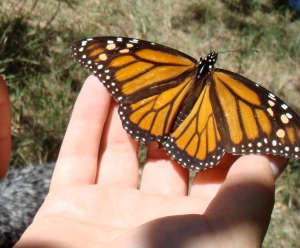Monarch Butterfly tags arrived this week from Monarchwatch, the organization, along with my friend Jenny Singleton, largely responsible for my fascination and love of butterflies. For those unaware, each Fall millions of Monarch butterflies head home from Canada to roost in the oyamel forests of Michoacan, Mexico for the winter. Lucky for us, the Monarchs must pass through the Texas “funnel” to arrive at their destination.

With our location on the Llano River, we are sometimes the host to masses of these migrants who roost in the riverside pecan trees and take nectar breaks on the Swamp Milkweed, Goldenrod and Cowpen Daisy. In 2008, we tagged almost 600 in a lucky strike that had our team of Monarch taggers working overtime. But it doesn’t always work out that way. Monarch season was a bit of a bust for us last year when they chose a more easterly route along the Gulf Coast and skipped us entirely. We only tagged 20 in 2009.

The Monarchs we see here in Texas in the fall are the likeliest to complete their trip and arrive in Michoacan where they will roost for the winter, wake up, mate, lay eggs and die. The cycle begins again. Their bodies are recovered by stewards of the nature preserves in Mexico, tag numbers are recorded, matched up to the data sent by taggers, and shared online.
Usually 1,000 – 1,200 tags are recovered each year, and two of our almost 600 tagged in 2008 were found in the spring of 2009. Of course the point of the tagging program is to provide empirical details that help scientists learn where the Monarchs come from, how far they fly, how they find their way. While much is still unknown, when it comes to the unique phenom of the Monarch Migration, the questions are as interesting as the answers. You can tag Monarchs in your yard throughout Texas this time of year. Keep an eye out, as they are passing through–the Migration is on and will get more intense through the end of October.
For my local friends interested in helping tag at the ranch this year, please leave a comment or send me a message and we’ll try to work out a schedule.

Leave A Comment